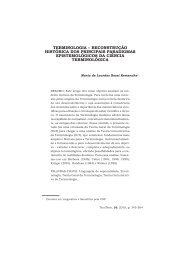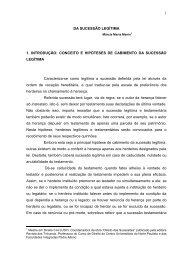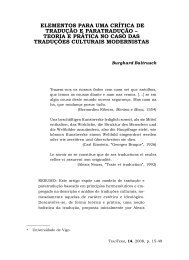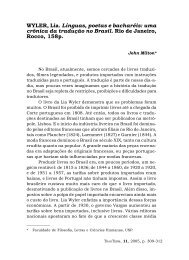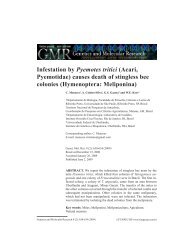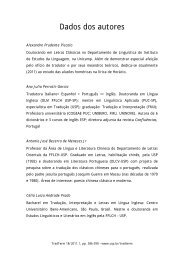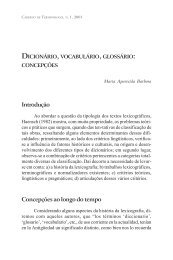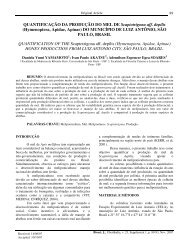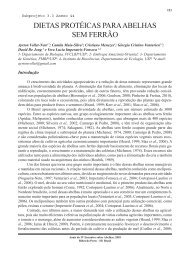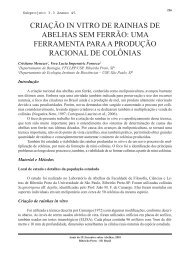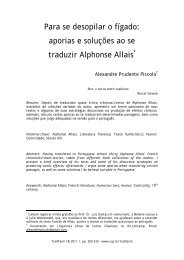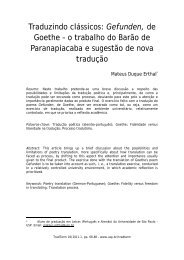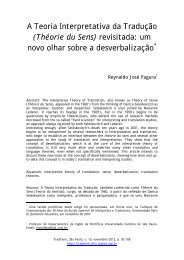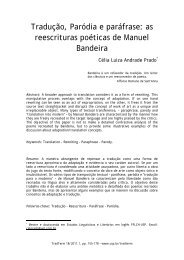Bees as pollinators in Brazil - USP
Bees as pollinators in Brazil - USP
Bees as pollinators in Brazil - USP
You also want an ePaper? Increase the reach of your titles
YUMPU automatically turns print PDFs into web optimized ePapers that Google loves.
64<br />
beekeep<strong>in</strong>g techniques, and truckloads of<br />
bees can be quickly and timely moved to flower<strong>in</strong>g<br />
crops (De Jong, 1996).<br />
Discussion<br />
Africanized honey bees have been used for poll<strong>in</strong>ation<br />
<strong>in</strong> greenhouses <strong>in</strong> <strong>Brazil</strong>. However many<br />
bees are lost from the colonies and it is difficult<br />
to ma<strong>in</strong>ta<strong>in</strong> the colonies alive under greenhouse<br />
conditions. Some researchers and beekeepers<br />
have been able to overcome these problems,<br />
but the techniques that they use are not published,<br />
nor is there an established system that<br />
works uniformly under all circumstances. Most<br />
attempts to use honey bees <strong>in</strong> greenhouses are<br />
<strong>in</strong>itially unsuccessful, however after numerous<br />
trials some researchers have been able to ma<strong>in</strong>ta<strong>in</strong><br />
colonies for long periods, efficiently poll<strong>in</strong>at<strong>in</strong>g<br />
the crop. In order to make efficient use<br />
of this resource, it will be necessary to make<br />
controlled studies, and develop standard, practical<br />
techniques that should be made widely<br />
available to beekeepers and growers.<br />
We can me<strong>as</strong>ure the result of us<strong>in</strong>g honey<br />
bees <strong>in</strong> greenhouses by exam<strong>in</strong><strong>in</strong>g the crop<br />
quantitatively and qualitatively. Normally, this<br />
is done by me<strong>as</strong>ur<strong>in</strong>g the weight, size and<br />
number of fruits, by determ<strong>in</strong><strong>in</strong>g the time till<br />
production of the fruits (which may be anticipated<br />
by adequate poll<strong>in</strong>ation), and by calculat<strong>in</strong>g<br />
the percentage fruits that are considered<br />
of high quality. Another important quantitative<br />
<strong>as</strong>pect is the cost and benefit of the poll<strong>in</strong>ation<br />
activities. Us<strong>in</strong>g honey bees h<strong>as</strong> a cost, and this<br />
should be compared with the ga<strong>in</strong> <strong>in</strong> crop production<br />
atta<strong>in</strong>ed with poll<strong>in</strong>ation. Photos of<br />
fruit that are produced by plants exposed to<br />
bees, versus those that are produced without<br />
bees, are often quite useful for illustrat<strong>in</strong>g the<br />
value of bee poll<strong>in</strong>ation. Appearance is important,<br />
<strong>as</strong> the color and shape of the fruit is<br />
often affected by poll<strong>in</strong>ation. Photos of cross<br />
sections of the fruit can show the number and<br />
distribution of the seeds, which are clear <strong>in</strong>dicators<br />
of poll<strong>in</strong>ation efficiency. The fruit quality<br />
can also be evaluated by me<strong>as</strong>ur<strong>in</strong>g sugar<br />
and prote<strong>in</strong> and other substances, and by evaluat<strong>in</strong>g<br />
organoleptic (t<strong>as</strong>te) factors.<br />
We already know how to manage<br />
Africanized honey bees <strong>as</strong> pol<strong>in</strong>ator for some<br />
crops, such <strong>as</strong> apples and melons, however<br />
this is not always done <strong>in</strong> the most efficient<br />
way. Many crops that would clearly benefit<br />
from the <strong>in</strong>troduction of bee colonies are not<br />
rout<strong>in</strong>ely poll<strong>in</strong>ated. Generally speak<strong>in</strong>g, poll<strong>in</strong>ation<br />
is little valued or understood by farmers,<br />
nor are beekeepers aware of the true<br />
value of the services that their bees provide.<br />
We have data <strong>in</strong>dicat<strong>in</strong>g significant <strong>in</strong>cre<strong>as</strong>es<br />
<strong>in</strong> fruit, seed and vegetable production due to<br />
poll<strong>in</strong>ation by Africanized honey bees, however<br />
little of this <strong>in</strong>formation is available to the<br />
growers. Often objective studies on commercial<br />
varieties are lack<strong>in</strong>g. This is true both for<br />
field crops and for greenhouse crops. The latter<br />
are unviable commercially unless adequate<br />
poll<strong>in</strong>ation is provided. Many crops are <strong>in</strong> fact<br />
poll<strong>in</strong>ated <strong>in</strong>cidentally by honey bees from<br />
nearby apiaries, or by wild honey bee colonies,<br />
however the grower is not aware of the<br />
importance of these services. Frequently he<br />
h<strong>as</strong> low production, without realiz<strong>in</strong>g that the<br />
re<strong>as</strong>on is a lack of <strong>poll<strong>in</strong>ators</strong>.<br />
The ma<strong>in</strong> difficulties with manag<strong>in</strong>g<br />
Africanized bees for poll<strong>in</strong>ation can be listed <strong>as</strong>:<br />
1.there are no established techniques for<br />
us<strong>in</strong>g Africanized bees under <strong>Brazil</strong>ian conditions<br />
on most crops;<br />
2.often the hives are not made with standard<br />
me<strong>as</strong>ures, or with <strong>in</strong>ferior materials, mak<strong>in</strong>g<br />
transport and management difficult;<br />
3.the bees are quite defensive and growers are<br />
often reluctant to place them <strong>in</strong> or near the<br />
crops that need poll<strong>in</strong>at<strong>in</strong>g;



